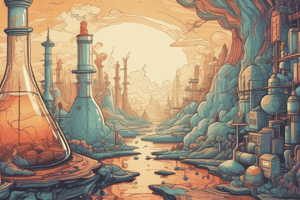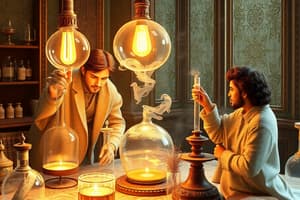Podcast
Questions and Answers
Which of the following is NOT a function of lipids?
Which of the following is NOT a function of lipids?
- Hormone production
- Cell membrane structure
- Genetic information storage (correct)
- Energy storage
Dehydration synthesis builds molecules by removing water.
Dehydration synthesis builds molecules by removing water.
True (A)
What are the monomers of proteins?
What are the monomers of proteins?
Amino acids
The process by which proteins lose their structure and function due to external stress is called ______.
The process by which proteins lose their structure and function due to external stress is called ______.
Match the following biological molecules with their primary function:
Match the following biological molecules with their primary function:
Which type of macromolecule serves as the primary energy source for cells?
Which type of macromolecule serves as the primary energy source for cells?
Hydrolysis breaks down molecules by adding water.
Hydrolysis breaks down molecules by adding water.
Which of the following is the correct sequence of steps in the scientific method?
Which of the following is the correct sequence of steps in the scientific method?
What is the name of the enzyme that breaks down hydrogen peroxide?
What is the name of the enzyme that breaks down hydrogen peroxide?
A hypothesis is valid if it is based on speculation and not necessarily testable.
A hypothesis is valid if it is based on speculation and not necessarily testable.
The ______ is the region on an enzyme where the substrate binds and the chemical reaction takes place.
The ______ is the region on an enzyme where the substrate binds and the chemical reaction takes place.
Which of the following is NOT a principle of cell theory?
Which of the following is NOT a principle of cell theory?
If a hypothesis does not explain observations, what should a scientist do?
If a hypothesis does not explain observations, what should a scientist do?
Enzymes are reusable by cells.
Enzymes are reusable by cells.
In the ‘if…, then… because…’ format for writing a hypothesis, the 'because' part provides the ______ for the prediction.
In the ‘if…, then… because…’ format for writing a hypothesis, the 'because' part provides the ______ for the prediction.
Match the following terms with their definitions in the context of experiments:
Match the following terms with their definitions in the context of experiments:
What is the primary difference between eukaryotic and prokaryotic cells?
What is the primary difference between eukaryotic and prokaryotic cells?
The ______ theory proposes that mitochondria and chloroplasts originated as free-living prokaryotes.
The ______ theory proposes that mitochondria and chloroplasts originated as free-living prokaryotes.
What should you use a line graph for?
What should you use a line graph for?
Which of the following is a type of passive transport?
Which of the following is a type of passive transport?
On which axis is the independent variable graphed?
On which axis is the independent variable graphed?
A graph title should always include the variables being measured, the unit of measurement, and a clear descriptive focus.
A graph title should always include the variables being measured, the unit of measurement, and a clear descriptive focus.
Active transport requires energy to move molecules across a membrane.
Active transport requires energy to move molecules across a membrane.
What does it mean when substances move down their concentration gradient?
What does it mean when substances move down their concentration gradient?
Facilitated diffusion is an example of active transport.
Facilitated diffusion is an example of active transport.
What is osmosis?
What is osmosis?
In a ______ environment, a cell gains water.
In a ______ environment, a cell gains water.
Match the following environments with their effects on cell water movement:
Match the following environments with their effects on cell water movement:
What type of transport do membrane pumps perform?
What type of transport do membrane pumps perform?
Where does photosynthesis primarily take place in a plant?
Where does photosynthesis primarily take place in a plant?
The byproduct of the light reactions in photosynthesis is glucose.
The byproduct of the light reactions in photosynthesis is glucose.
The main product of the Calvin cycle is ______.
The main product of the Calvin cycle is ______.
Which pigment is primarily responsible for absorbing light in chloroplasts?
Which pigment is primarily responsible for absorbing light in chloroplasts?
What is the primary purpose of reading the procedures of an experiment before and during an investigation?
What is the primary purpose of reading the procedures of an experiment before and during an investigation?
Experimental error occurs when a mistake is made during the experiment.
Experimental error occurs when a mistake is made during the experiment.
What are biotic factors? Provide two examples.
What are biotic factors? Provide two examples.
The trophic level with the greatest ____ is the producer.
The trophic level with the greatest ____ is the producer.
Match the following types of consumers with their definitions:
Match the following types of consumers with their definitions:
Which of the following is true about heterotrophs?
Which of the following is true about heterotrophs?
Scientists should manipulate data to support their hypotheses.
Scientists should manipulate data to support their hypotheses.
What is the difference between qualitative and quantitative data?
What is the difference between qualitative and quantitative data?
Fungi and bacteria are examples of ____.
Fungi and bacteria are examples of ____.
Which of the following elements is NOT one of the four most common elements that make up organisms?
Which of the following elements is NOT one of the four most common elements that make up organisms?
The pH scale measures the basicity of a substance.
The pH scale measures the basicity of a substance.
What is the lowest trophic level that a predator could occupy?
What is the lowest trophic level that a predator could occupy?
In an aqueous solution, the solvent is ____.
In an aqueous solution, the solvent is ____.
Match the following types of organisms with their energy acquisition methods:
Match the following types of organisms with their energy acquisition methods:
Flashcards
What is a hypothesis?
What is a hypothesis?
A testable prediction about the relationship between two or more variables.
What makes a hypothesis valid?
What makes a hypothesis valid?
It must be testable, falsifiable, based on evidence, logical, specific, and repeatable.
Why are controlled experiments important?
Why are controlled experiments important?
Scientists use them to isolate the effect of the independent variable on the dependent variable. Control groups are not changed, while experimental groups are.
What is the independent variable?
What is the independent variable?
Signup and view all the flashcards
What is the dependent variable?
What is the dependent variable?
Signup and view all the flashcards
When should you use a line graph?
When should you use a line graph?
Signup and view all the flashcards
What is a control group?
What is a control group?
Signup and view all the flashcards
What is an experimental group?
What is an experimental group?
Signup and view all the flashcards
What is the Biosphere?
What is the Biosphere?
Signup and view all the flashcards
What are Biomes?
What are Biomes?
Signup and view all the flashcards
What are Biotic Factors?
What are Biotic Factors?
Signup and view all the flashcards
What are Abiotic Factors?
What are Abiotic Factors?
Signup and view all the flashcards
What is a Community?
What is a Community?
Signup and view all the flashcards
Down the concentration gradient
Down the concentration gradient
Signup and view all the flashcards
What is an Organism?
What is an Organism?
Signup and view all the flashcards
What is Ecology?
What is Ecology?
Signup and view all the flashcards
Against the concentration gradient
Against the concentration gradient
Signup and view all the flashcards
What are Autotrophs (Producers)?
What are Autotrophs (Producers)?
Signup and view all the flashcards
What is osmosis?
What is osmosis?
Signup and view all the flashcards
What are Heterotrophs (Consumers)?
What are Heterotrophs (Consumers)?
Signup and view all the flashcards
What is tonicity?
What is tonicity?
Signup and view all the flashcards
What is a hypertonic environment?
What is a hypertonic environment?
Signup and view all the flashcards
What are Decomposers?
What are Decomposers?
Signup and view all the flashcards
What is a hypotonic environment?
What is a hypotonic environment?
Signup and view all the flashcards
What is an Energy Pyramid?
What is an Energy Pyramid?
Signup and view all the flashcards
What is the original source of energy in an aquatic ecosystem?
What is the original source of energy in an aquatic ecosystem?
Signup and view all the flashcards
What is an isotonic environment?
What is an isotonic environment?
Signup and view all the flashcards
What is facilitated diffusion?
What is facilitated diffusion?
Signup and view all the flashcards
What is an Element?
What is an Element?
Signup and view all the flashcards
What are Reactants?
What are Reactants?
Signup and view all the flashcards
What are membrane pumps?
What are membrane pumps?
Signup and view all the flashcards
What are Products?
What are Products?
Signup and view all the flashcards
What is an autotroph?
What is an autotroph?
Signup and view all the flashcards
Monomer
Monomer
Signup and view all the flashcards
Polymer
Polymer
Signup and view all the flashcards
Dehydration Synthesis
Dehydration Synthesis
Signup and view all the flashcards
Hydrolysis
Hydrolysis
Signup and view all the flashcards
Carbohydrate
Carbohydrate
Signup and view all the flashcards
Monosaccharides
Monosaccharides
Signup and view all the flashcards
Polysaccharides
Polysaccharides
Signup and view all the flashcards
Disaccharides
Disaccharides
Signup and view all the flashcards
Lipids
Lipids
Signup and view all the flashcards
Phospholipids
Phospholipids
Signup and view all the flashcards
Hydrophilic
Hydrophilic
Signup and view all the flashcards
Hydrophobic
Hydrophobic
Signup and view all the flashcards
Proteins
Proteins
Signup and view all the flashcards
Enzymes
Enzymes
Signup and view all the flashcards
Catalyst
Catalyst
Signup and view all the flashcards
Study Notes
Nature of Science
-
Scientific Method Steps (with examples):
- Observation: Why do plants grow taller in sunlight compared to shade?
- Question: Why do plants grow taller in sunlight compared to shade?
- Background Research: Research the role of sunlight in a plant's growth.
- Hypothesis: If a plant receives more sunlight, then it will grow taller because sunlight provides energy for photosynthesis.
- Experiment: Plant growth in inches over a time period with and without sunlight to test the hypothesis.
- Data Collection & Analysis: Measure the amount of inches grown.
- Conclusion: The plant in sunlight grew 7 cm taller than the plant without sunlight.
- Communication: Share results with the class.
-
Hypothesis Characteristics:
- Testable
- Falsifiable
- Based on evidence
- Logical
- Specific
- Repeatable
-
Controlled Experiments and Controls:
- Controlled experiments help determine if the independent variable truly causes the change.
- Controls isolate potential confounding variables
-
Graphing:
- Title: Includes variables, units, and description.
- Axes: Dependent variable (y-axis), Independent variable (x-axis).
- Line graph: Used for tracking change over time.
-
Control vs. Experimental Groups and Constants:
- Control group: not changed, experimental group: is changed.
- Constants: conditions kept the same.
-
Procedure Importance: Reading experimental procedures ensures safety and accurate data collection.
-
Error:
- Experimental Error: Problems during the experiment itself.
- Human Error: Mistakes made by individuals conducting the experiment.
- Both are important to account for.
-
Communication: Sharing results allows for accuracy checks and evaluation. Data should not be manipulated.
-
Inference vs. Direct Observation:
- Inference uses prior knowledge to guess an outcome.
- Direct observation records factual data.
-
Qualitative vs. Quantitative Data:
- Qualitative: non-numeric data (descriptions).
- Quantitative: data expressed in numbers.
Ecology
-
Biosphere: Earth's life-supporting region.
-
Biomes: Large ecosystems determined by climate and organisms.
-
Ecosystem Components:
- Biotic: Living (plants, animals, decomposers).
- Abiotic: Nonliving (temperature, water, sunlight).
-
Temperate Forest Biome:
- Deciduous trees (lose leaves seasonally).
- Common animals: deer, foxes, birds.
-
Ecosystem Organization (Simplest to Most Complex):
- Organism
- Population
- Community
- Ecosystem
- Biome
- Biosphere
-
Energy Transfer Roles:
- Autotrophs (Producers): Make their own food (photosynthesis/chemosynthesis).
- Chemosynthetic: Use chemicals as energy source.
- Photosynthetic: Utilize sunlight.
- Autotrophs (Producers): Make their own food (photosynthesis/chemosynthesis).
-
Heterotrophs (Consumers):
- Primary Consumers: Herbivores.
- Secondary Consumers: Carnivores or omnivores.
- Tertiary Consumers: Top predators.
-
Decomposers: Break down dead organic matter; fungi and bacteria.
-
Trophic Levels: Levels in the food chain/web with the flow of energy.
- Producers (most energy)
- Primary Consumers
- Secondary Consumers
- Tertiary Consumers
- Decomposers.
-
Energy Pyramid: Energy decreases at higher trophic levels.
-
Original Energy Source in Pond Ecosystem: Sunlight.
-
Energy Transfer Percentage: 10%
-
Predator: Organism that hunts and consumes others. Lowest trophic level: 2nd
Biochemistry
-
Elements: Basic substances cannot be broken down.
-
Common Elements in Organisms: Oxygen, carbon, hydrogen, nitrogen.
-
Chemical Reactions: Reactants (substrates) → Products.
-
pH Scale: Measures acidity; acids <7, bases >7.
-
Solutions: Mixtures with solute dissolved in solvent.
- Solute: Dissolved substance
- Solvent: Dissolving substance
-
Solvent in Blood/Cells: Water.
-
Monomers and Polymers:
- Monomers: Small units
- Polymers: Constructed from monomers.
-
Dehydration Synthesis: Builds molecules.
-
Hydrolysis: Breaks molecules apart.
-
Carbohydrates: Contain C, H, O.
- Monomers: Monosaccharides.
- Polymers: Polysaccharides (energy storage/structure), Disaccharides (energy).
- Function: Cell fuel.
-
Lipids: Fats, oils, hydrophobic.
- Phospholipids: Form cell membranes.
- Hydrophilic vs. Hydrophobic: Water-loving vs. water-fearing.
-
Proteins: Made of amino acids.
- Enzymes: Catalysts (speed up chemical reactions); reusable.
- Active site: Location of enzymatic activity.
- Activation Energy: Lowered by enzymes.
- Denaturation: Loss of structure and function due to changes in pH/temp.
- Enzymes: Catalysts (speed up chemical reactions); reusable.
-
Nucleic Acids: Carry genetic information— DNA and RNA.
- Monomer: Nucleotides.
- Genes: DNA segments, fuel currency— ATP
CELLS/CELL TRANSPORT (HOMEOSTASIS)
-
Cell Theory:
- All living things are made of cells
- Cells are the basic unit of life
- Cells come from pre-existing cells.
-
Cell Necessities: Nutrients (building blocks), oxygen (energy).
-
Cell Size Limits: Surface area-to-volume ratio (SA/Vol). Larger SA/Vol is better.
-
Eukaryotic vs. Prokaryotic Cells:
- Eukaryotes: nucleus, membrane-bound organelles
- Prokaryotes: no nucleus, no organelles.
-
Common Cell Parts: Cell membrane, nucleus, cytoplasm, mitochondria, endoplasmic reticulum, golgi apparatus, ribosomes, and cytoskeleton.
-
Plant Cell Unique Parts: Cell wall, chloroplasts, vacuole.
-
Endosymbiotic Theory: Mitochondria and chloroplasts were once free-living prokaryotes.
-
Organelle Evolution:
- Mitochondria: aerobic prokaryote
- Chloroplasts: cyanobacterium
-
Cell Transport:
- Selective Permeability: Cell membrane lets certain substances pass through.
-
Passive vs. Active Transport:
- Passive Transport: No energy required, movement with the concentration gradient
- Active Transport: Energy required, movement against the concentration gradient.
-
Concentration Gradient: Difference in concentration between two areas.
- 'Down' the gradient: high to low concentration
- 'Against' the gradient: low to high concentration.
-
Diffusion & Osmosis:
- Osmosis: Water moves from low to high solute concentration, across a membrane.
- Tonicity: Relative solute concentration in a solution.
- Hypertonic: Higher solute concentration outside the cell.
- Hypotonic: Lower solute concentration outside the cell.
- Isotonic: Equal solute concentration inside and outside the cell.
- Effects of each on water movement in/out of cells, and role of a cell wall.
-
Facilitated Diffusion: Passive transport using proteins to help molecules move across the membrane
- Aquaporins, ion channels, carrier proteins.
-
Active Transport: Membrane pumps move substances against their concentration gradient, requiring energy.
Photosynthesis
-
Autotrophs: Produce their own food— utilize energy from the sun.
-
Photosynthesis Process: Plants convert sunlight, CO2, and H2O into glucose and O2.
-
Photosynthesis Location: Leaves.
-
Gas Exchange: Stomata (pores).
-
Light Reactions Product: Oxygen.
-
Carbon Source: Carbon dioxide.
-
Chlorophyll: Absorbs light; reflects green light.
-
Chloroplast Structure:
- Thylakoids: Light-dependent reactions occur here.
- Stroma: Light-independent (Calvin cycle) reactions occur here.
-
Light-Dependent Reactions Inputs and Outputs:
- Inputs: Water, light, inorganic phosphate, NADP+, ADP
- Outputs: Oxygen, NADPH, ATP
-
Light-Independent (Calvin Cycle) Reactions: Convert inorganic CO2 into organic compounds.
-
Products: G3P, ADP, NADP+
-
Calvin Cycle Location: Stroma
-
G3P: Glyceraldehyde-3-phosphate.
Studying That Suits You
Use AI to generate personalized quizzes and flashcards to suit your learning preferences.





